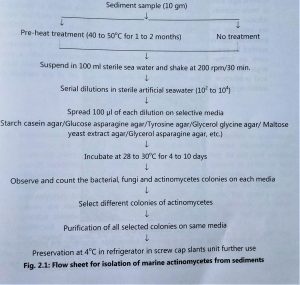Isolation of microorganisms
- Industrially important strains can be isolated from different natural sources. Samples are collected from natural sources to isolate bacteria, fungi, actinomycetes, or other microorganisms.
- All samples should be collected aseptically, with the aid of sterile spatulas, forceps, scalpels, gloves, and plastic bottles.
- Samples should be representative of all sites e.g. soil type, marine sand, sediment and mud, plant surface and parts, rhizosphere plane, and zone or water column.
- It should be labeled with a full description and date of collection. Seasonal and temporal aspects may be considered for the collection of samples.
- The actinomycetes population may decrease after heavy rainfall. Samples should be collected.
- From soil and water several inches deep because the surface contains a lot of dust particles.
- Water samples may be collected from estuaries, lakes, marine environments, streams essence the samples are brought into the laboratory, they should be examined immediately and stored at 4° C in the refrigerator.
The following techniques are used for the isolation of microorganisms.
- Media and ecological parameters: Incorporation of natural extracts and environmental biophysical parameters into media can affect the number and variety of microorganisms isolated in the laboratory. Some agar media contain extracts at concentrations of 10 to 50% of the total liquid volume. Infusions and extracts are usually prepared from soils, muds, leaves, roots, rocks, compost, barks, etc. Some agar media are prepared by the addition of multiple carbon and nitrogen sources or complex natural carbon-nitrogen sources, such as chitin, cellulose, or pectin.
- Non-selective isolation from soil: Standard dilution spread plate technique may be used to isolate microorganisms from the soil. Soil sample (1/5/10 gm) is mixed with 99ml of sterile saline solution and shaken at 100 to 150 rpm for 25 to 30 min. The soil suspension is serially diluted in the appropriate sterile diluent and 0.1 mi volume of diluents is spread onto the agar plates (spread plate techniques). For the isolation of actinomycetes, all samples (sediment, mud, or soil) are air-dried in sterile Petri plates at room temperature for 6 to 10 days. Plates are incubated upside down at 25 to 30°C for 5 to 10 days. The incubation temperature may depend on the original soil temperature and types of microorganisms. All plates should be examined every 2 days for new colony formation.
- Selective enrichment: Selective enrichments are designed to enhance the isolation of one or more species over the other species. Antibiotics such as penicillin, streptomycin, chloramphenicol, cycloheximide, chlortetracycline, polymyxin are incorporated in the media for the isolation of specific groups of actinomycetes and fungi. Preheat treatment is one of the important techniques mainly used for the isolation of actinomycetes. Soil samples may be treated at 40 to 120°C for 2 hours to 30 days and then used for isolation of heat-resistant actinomycetes. A combination of pretreatment with a suitable selective medium is necessary for the efficient isolation of certain genera. The selective isolation of bacteria may be performed by the addition of specific or desired enzyme systems such as chitin, cellulose, pectin, amino acids, metals, and antibiotic precursors in the media.
- Isolation from plant material: Plant parts such as flowers, leaves, stems, and roots are mainly used for the isolation of bacteria, fungi, and actinomycetes. Parts of plants are cut with a sterile scalpel or scissor in a laminar flow hood or clean room. A sample (1/2/5 gm) of plant materials is placed in a flask containing appropriate diluent. The flask is shaken at room temperature for 20 to 30 min (150 rpm). Sample (1 ml) is withdrawn and serially diluted. Three to four dilutions are spread onto plates containing plant isolation agars.
- Isolation from water: Water (50/100 ml) sample is filtered through a 0.22 um membrane filter. The membrane is gently scraped with a wide mouth 2 ml sterile pipette. The suspension is transferred to 9 ml of diluent and vortexed for 5 to 10 min. The sample is serially diluted and spread on selective media for isolation of actinomycetes, bacteria, and fungi. Pretreatment of water samples may enhance the number of actinomycetes. Microbial species may be isolated from water samples by centrifugation, Rhodococcus and Micromonospora species are selectively isolated by heating water samples at 55°C for 6 min. Actinoplanes species are isolated from flowing water on water agar plates made with filtered lake water or chitin agar and by incorporating 0.1% (w/v) potassium tellurite Colonies are picked with a flamed wire lop or sterile L-shaped needle or a sterile wooden stick and transferred to appropriate agars or replica plated for screening. Isolates are properly maintained and preserved to ensure genetic stability and high titer. Flowsheet for isolation of marine actinomycetes is shown in Figure

